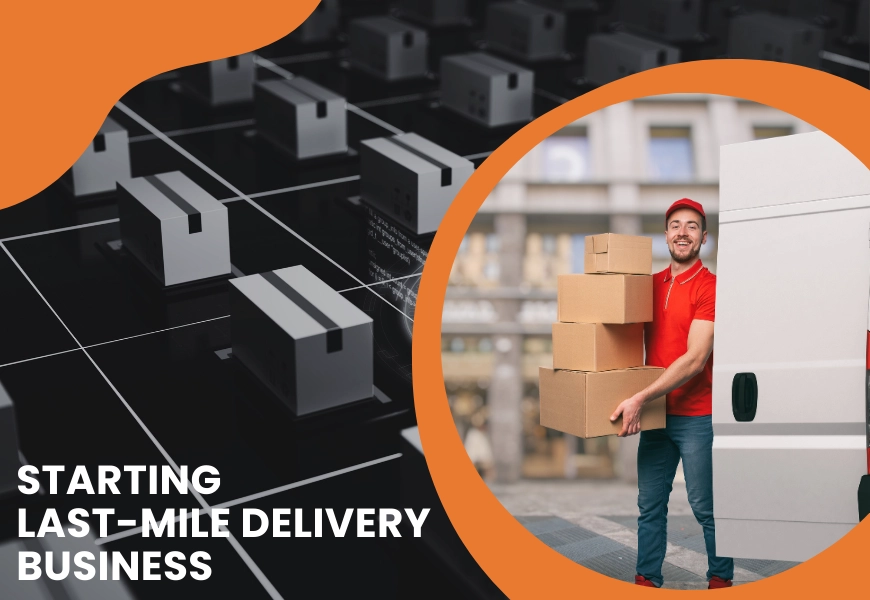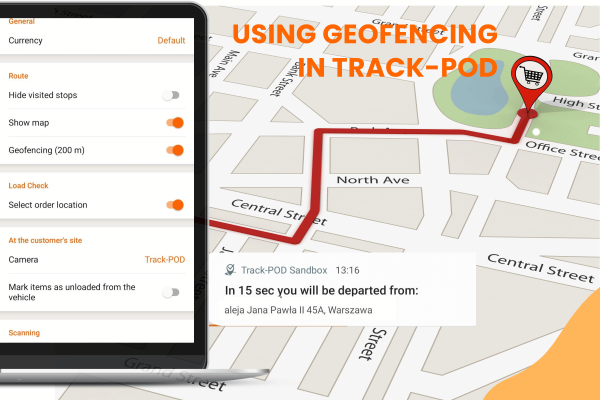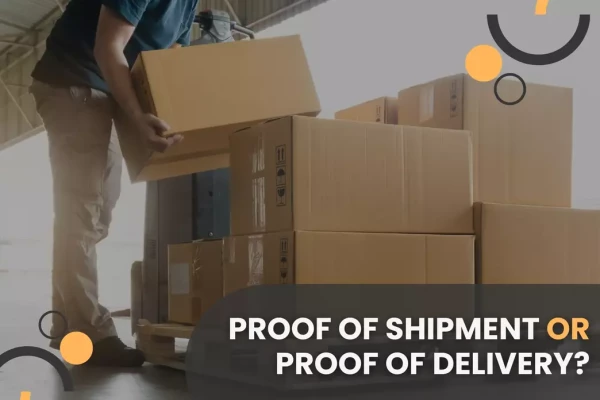How to Start Last-Mile Delivery Business in 2025

by
Alisa Cvilij
May 14, 2025
The forecasts say that last-mile delivery market will reach $424,3 billion by 2030. That counts for 41% of the total expenses in supply chain. That is no surprise as last-mile delivery is known to be one of the most expensive steps in supply chain!
But what about starting last-mile delivery business in those conditions? That kind of market growth definitely indicates potential for entrepreneurs wishing to start last mile company.
During the pandemic and till that day online shopping skyrocketed, AND more online shoppers = more deliveries!
Thus, if you are considering starting a last-mile delivery business, this article is for you!
Keep reading and find useful information written in a step-by-step guidance format on how to start a last-mile delivery business in 2025.
I will reveal challenges of last-mile delivery business, costs of starting last-mile delivery company/business, and more!
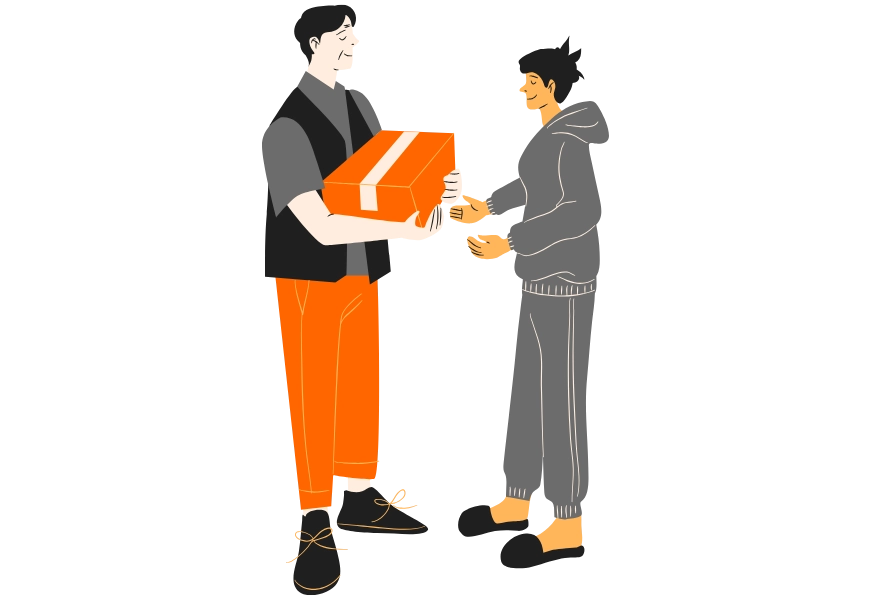
What is a last-mile business and how does last-mile delivery work?
Last-mile delivery is the last service step of the delivery process. Or you can say it is the final step of delivering goods to a to customer’s doorstep. If you are new to the concept of last mile delivery and need more information on what it is, I recommend reading this article.
Managing multiple deliveries, delivery times, drivers, vehicles, all of that can be rather complex, thus in 2025 many businesses take advantage of utilizing technology to improve customer satisfaction and business competitiveness.
Hope the introduction was clear and let’s move on to finding out what are the types of last-mile deliveries in general available currently and what are their differences.
Types of last-mile delivery businesses
Lets dive in details of the types of last-mile delivery businesses. Each type can be a good fit for specific industry you will specialise in and reflect to specific needs of your potential customers.
The most common types of services you could provide as last-mile delivery business:
- Traditional courier services. From point to point delivery of packages and/or documents.
- On-demand delivery services. Offers different flexible delivery options. Services could be provided through last-mile delivery apps or platforms that connect customers with delivery drivers for quick and convenient deliveries.
- Specialized delivery services. Special delivery types focused on specific industry desires and conditions. Example pharmaceutical goods, groceries, flowers, oversized items like furniture, or appliances. If you are interested in becoming specialized as a medical courier, you can read our article here.
- Same-day or instant delivery services. As the name says, those last-mile delivery businesses would offer expedited delivery options as same day or instant delivery.
- White-glove delivery services. White glove delivery is known as premium delivery services.. They provide additional services like installation, assembly, or personalized customer support. To find out more about white glove delivery and business benefits of it, check this article.
- Smart Locker Networks. Those are delivery businesses that offer secure, self-service lockers in convenient areas where customers can pick up their deliveries whenever they want.
Is it worth starting a last-mile delivery business?
If we look at statistics again, last-mile of total shipping costs in 2018 was 41% and has grown to 54% by 2023. Assuming the popularity of online shopping, that also has a potential of growth. But it is obviously necessary to consider obstacles, costs, your interest in the industry before starting.
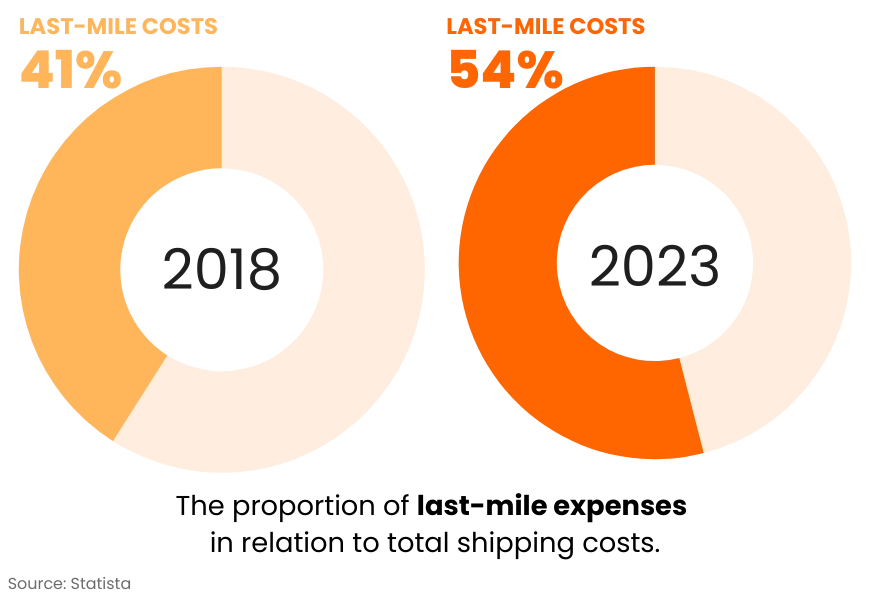
Starting from scratch: A guide on how to start a last-mile delivery business in 2025
Anyone who is starting a last-mile delivery business should read this comprehensive guide to know how to start from scratch.
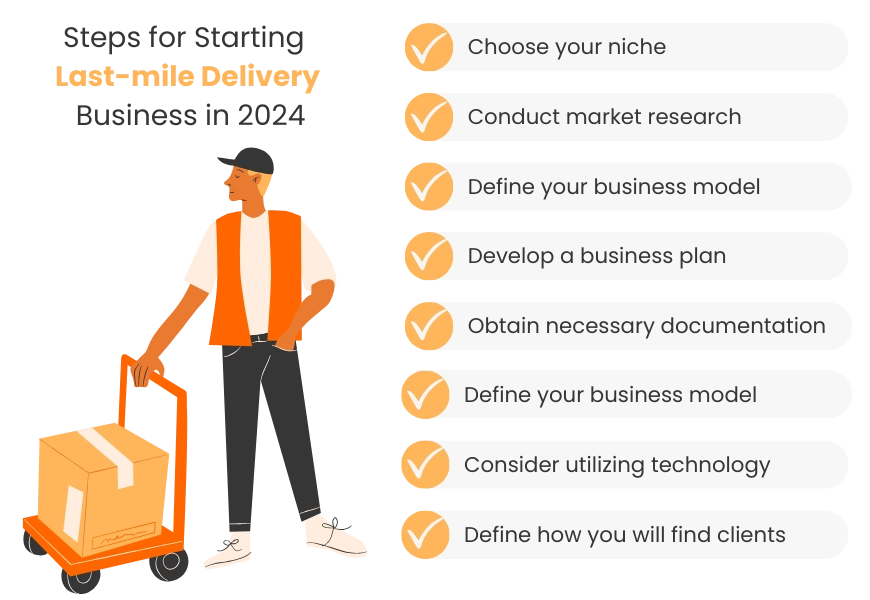
GUIDE:
Choose a niche
Conduct a market research
Define your last-mile business model
Develop a last-mile delivery business plan
Obtain licenses and permits for your last-mile delivery service business
Consider costs when starting your last mile business
Pick the right software
Hire the right staff
Find clients
1. Choose a niche for your last-mile delivery company.
There are plenty of delivery services, popular niches include food, flowers, pharmaceutical items, laundry, dry cleaning, party and event items, furniture and more.
2. Conduct market research
Some of the main things that should be included in your market research:
- Define your business objectives. As an example, you would choose to provide best customer service, efficiency, etc.
- Analyze industry trends. Check customer behavior and trends in the niche you selected, either analyze niches if you have not selected one yet. Look at what are the problems to be solved in particular niche, check customer behavior, technology trends, any special regulations.
- Determine your target audience. Identify your customer audience, what are they looking for, their geography, purchasing power, how to reach them.
- Analyze your competition. Look at what your competitors offer - what are their strengths and weaknesses.
- Research on customer feedback. Gather customer reviews through surveys, focus groups, or forums.
- Make a SWOT analysis. It will consist of your strengths, weaknesses, opportunities and threats. Here is a guide.
3. Define your last-mile business model
Last-mile delivery business models can also vary based on how many owners, stakeholders are involved, thus it is something important to consider. Best model/option to operate a last-mile business might depend on the number of owners and regulations in your particular country. Some examples are below:
- A sole proprietorship involves a single owner who operates a business and is solely liable for all debts and obligations.
- A Partnership entails two or more individuals who share ownership and responsibilities.
- A Corporation is a business structure considered a separate legal entity from its owners, protecting the owners from being personally responsible for the business debts.
- An LLC, or Limited Liability Company, is a business structure in which owners are protected from personal liability for their company’s debts.
4. Develop a last-mile delivery business plan
Business plan can consist of many variables, thus outlining your business concept, target audience, evaluating your financial projections and available assets can help you develop a last-mile delivery company plan specifically for you.
In addition, you should describe your company’s mission, vision, and values while emphasizing the key value that distinguishes you from your competitors.
A good business plan includes:
- Executive summary
- Business description
- Market analysis and strategy
- Marketing and sales plan
- Management and organization description
- Products and services description
- Competitive analysis
- Operating plan
- Financial projections and needs
- And anything else what could be relevant to your particular market. Example “Exhibits and appendices” Maybe you will need special licenses to operate your business or etc.
Your business plan is likely to get some revisions as your last mile delivery company keeps growing.
5. Obtain licenses and permits for your last-mile delivery service business
Please keep in mind that licenses, permits can vary based on your niche and the country you operate in.
Some common examples of licenses and permits you might need are listed below:
- Basic business license: Once you register, you must obtain a business license to operate legally.
- Employer Identification Number (EIN): The staff you’ll employ must have an EIN from the IRS for tax purposes.
- Transportation licenses: Obtain all required permits for your last-mile delivery vehicles.
- Vehicle registration and insurance: Ensure the vehicles you’ll use for delivery are registered and insured.
- Operating permits: Some last-mile delivery businesses must obtain specific licenses related to zoning, noise, and environmental regulations.
- Health and Safety Permits: If your last-mile delivery business is about food deliveries, you must obtain health and safety permits to ensure compliance with food regulations.
6. Consider costs when starting your last mile business
Once you have an idea of the size and scope of your last-mile delivery business, you have to analyze its costs. Please see below presented some of the variables, that you might want to consider.
A few factors can impact last-mile delivery costs, such as the staff you’ll have to pay for the service, obtaining licenses and permits, and the equipment you’ll use.
Or, as Starter Story claims, the average startup cost for a delivery service of any kind is $19,267.
Here is a list of the basic last-mile delivery company costs that you should consider:
Let’s say that you’ll have a brick-and-mortar location for your business. There will be expenses for the rent that need to be paid, and depending on where you want it to be located, the rent costs can vary.
Rent costs are accounted for 10% of the total last-mile delivery expenses.
Once you form your last-mile delivery business, you must obtain trademarks, copyrights, business insurance, permit and license fees, and lawyer fees.
Your business needs software to run smoothly in this digital era.
The software will save you time and money by automating certain functions while helping you grow your business. It should include a CRM (Customer Relationship Software), accounting and invoicing software, email marketing tools, internal communication tools, IT support, social media management tools, and payroll software.
The costs of delivery management software account for 10% to 15% of the total cost of last-mile delivery.
Labor costs are the biggest expense when starting a last-mile delivery business.
The staff that needs to be hired, mainly delivery drivers, costs a lot to hire, maintain, and train, accounting for 50% to 60% of last-mile delivery costs.
-
Setting a business website
Most successful businesses have official websites. It is worth investing money in setting up your last-mile business website.
There will be costs for getting a domain name, website hosting, a website builder, a business email hosting service, and web design.
The business website setup can take up to 7% of the total last-mile delivery expenses.
-
Transport equipment (vehicles)
Your last-mile business will need its mode of transportation, so you’ll need to invest in durable equipment. Also, remember that the delivery vehicles you purchase or lease must be maintained regularly.
Last-mile delivery vehicle costs are accounted for 10% of the total last-mile delivery expenses.
Fuel expenses can add up quickly, and their prices can often fluctuate, leading to unexpected costs. On average, they account for 10% to 15% of the overall expenses. To calculate your cost per mile, let me share with you this cost per mile calculator, that you can download in the excel format.
Any business needs advertising initially until it sets a good foot on the market for such companies. Consider costs like business cards, signage, printing and mailing, Google Ads, and Facebook and Instagram ads.
On average, marketing and advertising expenses account for 5%.
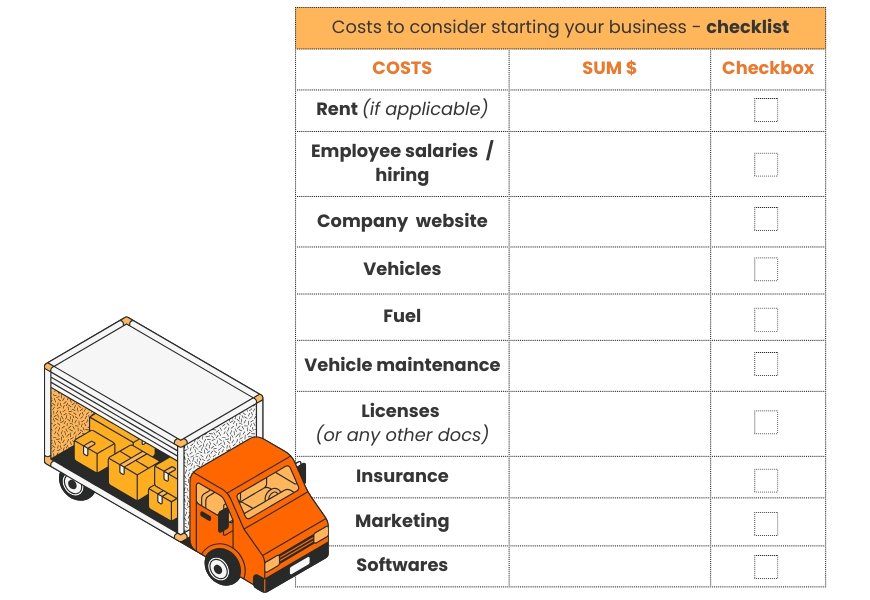
7. Pick the right software
When it comes to running a business like a last-mile delivery service, technology is an indispensable asset.
The delivery management software of last-mile delivery businesses is meant to streamline most delivery operations.
Automation processes are crucial for all last-mile delivery businesses.
Invest in deploying a last-mile delivery tracking platform (software) to handle delivery automation, route optimization, real-time monitoring, automatic order scheduling, and push notifications for every delivery milestone.
The software can automate customer queries and collect feedback with suggestions to improve delivery services. It also offers proof of delivery and analytics to determine whether the scheduled order was delivered. Example of the Track-POD delivery management software is below.
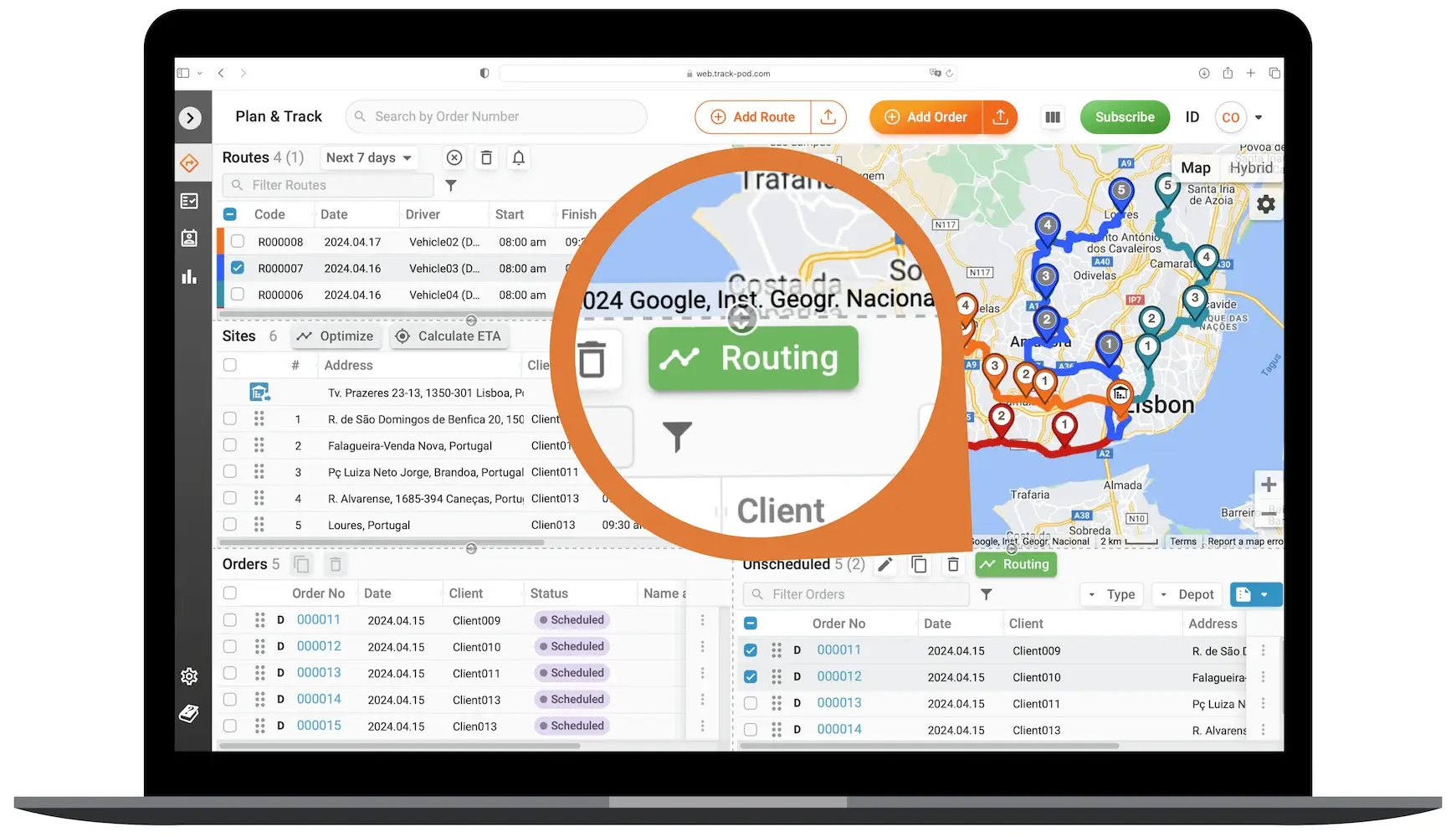
8. Hire the right staff
To hire the right staff for your last-mile startup, you can use recruitment agencies to seek qualified and experienced staff.
Good to Know: According to Salary, the average salary for a last-mile delivery driver in the US is around $50,600 annually.
The logistics and shipping workers your business needs must have soft skills. Here is a breakdown of the vital ones you should evaluate in potential candidates:
- Problem-solving—Your staff must know what to do when encountering unexpected issues. You can test their problem-solving skills by asking them hypothetical questions and asses their approach to finding a solution.
- Effective communication—Communication is paramount to running any successful business. Ask candidates questions to assess their communication style and pay attention to how they articulate ideas clearly.
- Attention to detail—All details are important when managing inventory. You should ask candidates about their experience completing meticulous tasks requiring precision.
- Excellent time management—Time is money, and timely deliveries cannot be negotiated. You should ask candidates for their strategies for prioritizing tasks and handling deadlines.
- Adaptability— Last-mile delivery services are constantly evolving. You must ask candidates how they would adapt to changing circumstances. Perhaps you can pose a hypothetical situation, such as how they would adapt if there is a sudden change in shipment schedules.
Teamwork - Good logistics staff collaborates with different stakeholders. Ask candidates about their work experience in cross-functional environments.
9. How to find clients
After you’ve done all the hard work mentioned above, it's time to find and grow your customer base.
We laid down a few tips to kickstart your delivery service:
You can promote your last-mile startup on social media platforms like Instagram, Facebook, or TikTok. Create a profile to build connections with potential clients and advertise your services.
- Partner with e-commerce platforms
Many small businesses sell online but need help with delivery logistics. You can partner with such companies and offer customized last-mile delivery solutions.
- Offer promotions and discounts.
Promotions and discounts are attractive and can help you get your first clients. For example, you can discount the first ten deliveries or provide a short trial period to allow potential clients to test your services.
- Connect with local businesses.
Networking with local businesses is important because it might offer partnerships where you can provide your delivery services.
What are the essentials for launching a last-mile delivery service?
There is a basic starter kit for launching a last-mile delivery business. Here are the essentials that you should know when starting one:
- Business permits and licenses
- Delivery vehicles (cargo van, bicycle, car or truck)
- Drivers with valid driver’s licenses
- Smartphones or tablets
- Auto insurance for the vehicles
- Navigation software
- Packing supplies
What are the last-mile delivery challenges?
There is a big pressure on logistics companies seeking ways to optimize their last-mile operations.
Here is a brief of some of the most intense last-mile delivery issues and challenges:
- Navigation through congested urban areas
- Delivery on time
- Package theft and security
- Environmental impact and sustainability
- Workforce shortage
How can technology be beneficial for last-mile delivery businesses?
Technology can be very beneficial in addressing the challenges that last-mile delivery businesses face.

All last-mile delivery entrepreneurs should take advantage of the advent of innovative technology solutions like drone delivery, route optimization software, or micro-fulfillment centers.
- Drone delivery is a great option for last-mile delivery, especially in areas that are hard to reach. These devices can overcome the challenge of traffic congestion and can deliver the package to the customer on time.
- Machine learning technologies improve delivery routes based on weather conditions, traffic patterns, and priorities.
- MFCs, or micro-fulfillment centers, use robotics and automation to speed up order processing and bring orders closer to the end customer.
- Delivery Management Software integrates with your website or allows manual file uploads, schedules routes, offers free driver’s apps, offers live tracking, and custom notifications to customers.

Wrapping up
Hopefully, this piece gave you insider tips on how to start a last-mile delivery company in 2025.
Remember that once you open your last-mile shipping company, the technology you’ll use will be crucial to its success.
Invest wisely in it and focus on implementing advanced solutions because the future of last-mile delivery businesses is all about technology.
Keep this article as a reminder starter kit for all you need to know about starting a business in the last-mile delivery industry.
At Track-POD we offer delivery management software that provide route optimization, proof of delivery, live tracking features and many more! Sign up for 7 days free trial or get a demonstration.
About The Author
Alisa Cvilij
Content Marketer at Track-POD. Passionate about building meaningful and helpful content for the readers.

